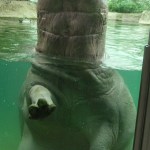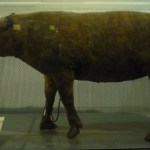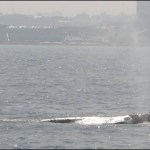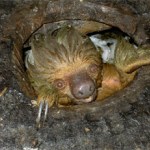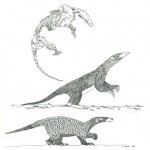mammalogy
The Pronghorn or Pronghorn antelope* Antilocapra americana is a strikingly unique artiodactyl, endemic to western North America. Historically, it ranged from southern Manitoba and Washington in the north to northern Mexico in the south, and to western Iowa in the east. Between 40 and 50 million Pronghorns were alive in 1850; excessive hunting had reduced this number to 13000 by 1920. Subsequent conservation efforts have resulted in substantial recovery: there are currently between half a million and one million Pronghorns.
* Also known as the Cabrit, Prong Buck, Speedgoat (my favourite) or…
Thanks to everyone who had a go at guessing the identity of the mystery stuffed carnivoran. I am pleased, I suppose, to say that NOBODY GOT IT RIGHT, but some of you did come close.
First of all, given that I specifically referred to the animal as a carnivoran (that is, a member of the placental mammal clade Carnivora), those of you suggesting that it might be a marsupial (like a Thylacine or Tasmanian devil) should consider yourselves chastised. Also, I should note that the file name was specifically written in code and did not contain any clues to the creature's identity.
The specimen is…
Test your skills and identify this carnivoran (sorry the image isn't larger: this is all I got). It's not meant to be particularly easy, so good luck. The person who supplied the image is not allowed to play, and it would be appreciated if another individual who has used the same image on his own blog refrained from spoiling things as well :)
I'll publish the answer within the next day or so. Good luck.
How the hell did seals get into Lake Baikal? Actually, if you're a long-time reader you'll know the answers that have been put forward (note there that I didn't say "you'll know the answer"), as I covered this issue back in 2006 on Tet Zoo ver 1. In the interests of recycling old stuff and saving myself valuable time and effort, here's that article again...
One of the most asked about questions I've encountered in tetrapod zoology concerns the mysterious seals of Siberia's Lake Baikal. Everyone knows that an endemic, particularly small species of land-locked freshwater seal lives there,…
Here's a very simplified 'consensus cladogram' for Artiodactyla: hey, just like it says in the title. Obviously, it only features living taxa. The reference cited on the side (it's a slide from a talk about hoofed mammal evolution) is...
Price, S. A., Bininda-Emonds, O. R. P. & Gittleman, J. L. 2005. A complete phylogeny of the whales, dolphins and even-toed hoofed mammals (Cetartiodactyla). Biological Reviews 80, 445-473.
Discuss!
Here's a pretty weird looking photo; it comes courtesy of Markus Bühler (of Bestiarium) and was taken at Berlin Zoo. I don't think I'm spoiling the surprise by saying that it shows a Hippopotamus amphibius....
... albeit a peculiar individual who seems to suffer from prolapsed tissue around the corners of her mouth. Initially I was going to use this view of a hippo to say something smart about the whippomorph hypothesis, but.. naaah. With a bit of photoshopping, I'm sure someone could make the picture look like it portrays some kind of horrendously ugly water monster. Maybe cropping the…
I don't want to get into the habit of advertising TV shows, but in this case I can make a definite exception. Thanks to the people at Windfall for sending what's known in the business as a TX card. For the Tet Zoo articles on series 1, see...
Inside Nature's Giants: a major television event worthy of praise and accolade. Part I!
Inside Nature's Giants part II: whale guts and hindlimbs ahoy
Enough mammals for the time being: crocodiles on Inside Nature's Giants (part III)
Inside Nature's Giants part IV: the incredible anatomy of the giraffe
One of the most significant papers ever published in the annals of science appeared recently; it deals, for the first time ever, with one of the biggest scientific questions ever faced by the scientific community, and uses cutting-edge technology and awesome powers of deductive reasoning and logic to reach shocking, paradigm-shifting conclusions. I refer, of course, to Don Henderson and Darren Naish's Journal of Theoretical Biology article 'Predicting the buoyancy, equilibrium and potential swimming ability of giraffes by computational analysis'. I'm sure you've already read it and have…
Yet another 'sea monster carcass' was brought to my attention recently (thanks Paul), and in the interests of tradition and of bringing it to a wider audience I thought I should include it here (I'm very late to the party: Cryptomundo discussed the case when it broke three years ago). Dubbed the 'Conakry Monster', it washed up on the coast of Guinea in May 2007. It was described as being a gigantic crocodile/lizard monster with an armoured back, fur, a long tail and 'four paws'! The blackened surface to the skin led some people to think that it might have been burnt... somehow.
The Russian…
Yet again, a waterlogged, partially decomposed mammal carcass has become "an internet sensation" (to quote the popular media), and yet again people are saying it might be a new 'Montauk monster', or a Chupacabras, or a relative of Nessie, or Ogopogo, or a baby sasquatch, or some other sort of ungodly monster. The back-story is that the carcass was pulled from the water of Big Trout Lake near the community of Kitchenuhmaykoosib Inninuwug, Ontario, earlier in May this year. It's a rather small (30 cm total length), dark-brown mammal carcass that's lacking hair on its face and at least one of…
I covered babirusas recently; you might have noticed. As you'll know if you read those articles, Meijaard & Groves (2002a, b) argued a few years ago that Babyrousa babyrussa of tradition should actually be split up into several phylogenetic species. Coincidentally, I published an article on lumping vs splitting in extant mega-mammals only a few weeks before Groves et al. (2010) split white rhinos into two phylogenetic species.
Among the most distinctive of the 'newly recognised' babirusa species is the Hairy or Golden babirusa. Somewhat ironically, it seems that babirusas of this sort…
It's just too good not to mention. Yesterday I re-posted an old article about manatee dispersal across the Atlantic. And on the same day came news that a living Grey whale Eschrichtius robustus has been seen off Herzliya Marina, Israel, meaning that at least one living, breathing Grey whale is currently swimming around in the Mediterranean (in order to make sure that Americans pick up this article while googling: Gray whale Gray whale Gray whale). A team of experts were sent out to look at it: they verified the identification and got great photos, like this one...
As has been mentioned by…
No time for anything new (working on a book chapter and putting the finishing touches to the Tet Zoo book), so here's this, from the archives. NOT properly updated, so please be aware that it's more than four years old...
There are three extant manatee species*: Trichechus inunguis of the Amazon Basin, T. manatus of the Gulf of Mexico, Caribbean and US Atlantic coast as far north as Virginia, and T. senegalensis of western Africa. So, how it is that they occur on opposite sides of the Atlantic? [West Indian manatee T. manatus shown here, from wikipedia. This one was photographed in Florida…
It's official: there's a new, living species of African rhino, bringing the recognised number of living rhino species to six.
But before you get too excited I should point out that the taxon concerned is not exactly new. It was first named in 1908 and has previously been regarded (without exception) as a 'subspecies'.
It's the Northern or Cotton's white rhinoceros (aka Grass rhino or Square-lipped rhino) Ceratotherium cottoni [captive individual shown above; photo by Jan Robovsky, from Groves et al. (2010)], previously classified as Ceratotherium simum cottoni, and first named by Richard…
Can you identify this peculiar odontocete? As always, dead easy. IF you know the answer. Thanks to Markus Bühler for the image.
Oh, and while I'm here...
On a completely different topic... I was once told that numerous birds die while flying close to or over offshore oil platforms [adjacent pic from wikipedia].
Supposedly, the birds are poisoned by the vented gases, and gather in some numbers on the decks. Is this complete nonsense, or might there be some truth to it? Can you provide more information? Having looked - and, believe me, I've spent a lot of time tracking down literature on…
I really like sloths, but one of their recently discovered habits might make me like them a little bit less...
As recently reported by Eckhard Heymann and colleagues, Linnaeus's two-toed sloths Choloepus didactylus at the Estación Biológica Quebrada Blanco in north-eastern Peru have developed the delightful habit of climbing into an outdoor latrine building, seeking out the latrine contents AND EATING THEM (Heymann et al. 2010).
The behaviour was first reported in November 2001 when a sloth was discovered hanging from the wooden bars within the latrine. "It was scooping with one hand from…
If anything should be clear from the range of creatures that I write about at Tet Zoo - think caecilians, borhyaenoids, imaginary giant owls and rhynchosaurs - it's that there's an almost infinite amount of technical information on obscure creatures 'locked away' in the technical literature. Among the most remarkable of mammals are, without doubt, the winged cats or pantheropterygines, yet for all their fame and notoriety, most of the information on these creatures has remained widely scattered in the literature and a good synthesis is absent.
Winged cats were first brought to scientific…
I like to think that I've done my bit for babirusa promotion. Hopefully you agree. And babirusas could do with lots of promotion - not only are they fascinating and bizarre, they're globally endangered and in real need of protection (if you want to know more, check out Babirusa.org).
I'm pleased to announce that my babirusa articles here at Tet Zoo have not only inspired an endearing cartoon, but something equally fantastic and captivating... a knitted babirusa!
Sasha Kopf - or Tapir Girl, if you prefer - mostly knits tapirs (as you can see from her collection of photos here). She's…
As some of you might know, all of my 'free' time last month was eaten up by a major project (a book chapter) that had a very tight deadline. This meant no time whatsoever for such stuff as blog-writing, hence the (mostly) recycled babirusa stuff. That project is now (mostly!) complete, but I'm still struggling for time due to other projects and jobs. Meanwhile, I thought I'd recycle this...
The illustration was previously used here, back on ver 1 in 2006, and again here in a ver 2 article on ameghinornithids. Eurotamandua joresi, shown at top as a skeleton and in the middle as a life…
It turns out that Martinus van Tee of Caricature a day (and of martinus van tee illustration) is a big fan of Tet Zoo, and obviously of babirusas too. Yes, here's me, Flintstone-style, riding a familiar artiodactyl. Have I written about babirusas on Tet Zoo? - - I can't remember.
Thanks indeed Martinus, truly I am honoured. In real life, remember that babirusas need help: they are threatened by illegal hunting and habitat destruction on Sulawesi (visit Babirusa.Org for more).





